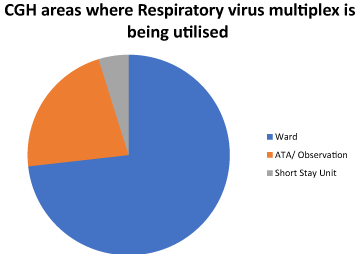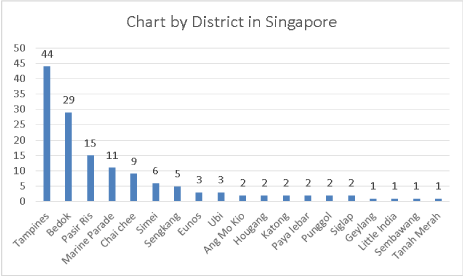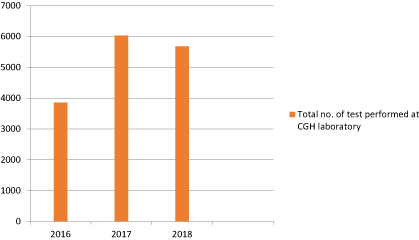influenza, PCR, Changi General Hospital
Influenza is an acute respiratory illness which is usually self-limiting but sometimes can be acutely debilitating. To prevent further complications, it is important that we can diagnose the symptoms early. During an influenza outbreak, acute febrile respiratory illnesses can be diagnosed as influenza with likelihood by clinical criteria. At other times, it is important to establish the diagnosis quickly using laboratory testing. The most sensitive and specific modality for diagnosing influenza infection is the conventional reverse-transcriptase polymerase chain reaction (RT-PCR). It yields relatively rapid results and differentiate between influenza types and subtypes [1]. This retrospective study was conducted in Changi General Hospital, a 1000 bedded, acute care hospital in the eastern part of Singapore.
Our objective was to determine whether there was an outbreak of Influenza during the month of June 2017 and to determine the impact of Multiplex Polymerase Chain Reaction testing for respiratory pathogens on early detection of influenza outbreak in adult patients.
Data were collected from the CGH laboratory as we noted increase in laboratory tests of BiofireFILMARRAY® Respiratory Panel (RP)(Biomerieux) in June 2017.
A total number of 672 patients were identified for which Respiratory virus multiplex PCR was ordered in June 2017. There were 358 males and 314 females. Figure 1 shows the locations where throat swabs for multiplex PCR for respiratory virus were utilized: ward (492 throat swabs, 73.2%) and emergency room (Admission and Transit Area/Observation – 148 throat swabs, 22%, Short stay unit- 32 throat swabs, 4.8%).

Figure 1. CGH areas where Respiratory virus multiplex is being utilized.
The clinical diagnosis of the patients included pneumonia (20.8%), upper respiratory tract infection (13.9%), bronchitis (4.2%), and lower respiratory tract infection (4%). These patients also had pre-existing medical illness, ESRD/CKD (13.5%), asthma (12.2%), COPD (7.6%), and CCF (2.4%) (Table 1).
Table 1. Baseline characteristics of patients diagnosed with Influenza.
Age |
Number |
Co-Morbidity |
Nil |
DM |
Asthma |
COPD |
CCF |
ESRF/CKD |
≥ 65 |
106 |
2 |
49 |
12 |
7 |
4 |
14 |
45-64 |
27 |
1 |
13 |
5 |
0 |
0 |
2 |
18-44 |
10 |
4 |
1 |
1 |
0 |
0 |
2 |
Detailed analysis of the data show that patients presented with chest x-ray with definite consolidation in the lungs (226 patients,33.6%). Positive cases for Influenza were 184 (27.4%) (Table 2). Among the influenza cases, Influenza A H3 was the highest (142 patients,77%) followed by Influenza B (24 patients, 13%) and Influenza A H1 (15 patients, 8.1%). There were 135 (73.4%) patient who were diagnosed with influenza received Oseltamivir (Tamiflu). Table 1 shows the baseline characteristics of patients diagnosed with Influenza A H3. The average length of stay of infected Influenza A H3 patients in the hospital was 10 days.
Table 2. Respiratory pathogens detected on FILMARRAY® RP.
Viruses |
Number of patients (%) |
Influenza
- Influenza A H3
- Influenza A H1
- Influenza B
- Influenza A (equivocal)
|
142 (77%)
15 (8.1%)
24 (13%)
3 (1.6%) |
Rhino/ Enteroviruses |
39 (5.8%) |
Respiratory syncytial virus (RSV) |
25 (3.7%) |
Human Metapneuomovirus |
15 (2.2%) |
Parainfluenza virus |
13 (1.9%) |
Mycoplasma pneumoniae |
4 (0.6%) |
Chlamydia pneumoniae |
0 |
Bordetella pertussis |
2 (0.3%) |
Out of 672 patients tested for FILMARRAY® RP, other respiratory viruses prevalent during this period included Rhino/Enterovirus (39 patients, 5.8%), Respiratory Syncytial virus (25 patients, 3.7%), Human Metapneumo virus (2.2%), Parainfluenza virus (13 patients, 1.9%), and Corona virus (1.3%). A small percentage of atypical bacterial infections identified respiratory swab PCR method which included Mycoplasma pneumoniae (4 patients, 0.6%) and Bordetella pertussis (0.3%) (Table 2).
We have looked into Medical Intensive Care Unit (MICU) admissions during June 2017 period. Out of 85 patients admitted that were admitted, 39 (45.9%) utilized Respiratory virus multiplex PCR. Detailed analysis in MICU also showed that Influenza A H3 accounted for 8 patients (20.5%). Only 1 patient did not receive Oseltamivir. Three (37%) of MICU patients with Influenza A H3 died with concomitant pneumonia which include one of the patient who did not received Oseltamivir.
This study also identified that Tampines district shows the highest number of Influenza A H3. It was followed by Bedok then Pasir Ris district. Figure 2 shows data on the district areas of Singapore where Influenza A H3 was prevalent.

Figure 2. Prevalence of influenza A H3 in 2017.
We have analysed the number of tests ordered for Respiratory virus multiplex PCR (BiofireFILMARRAY) from 2016 to 2018. Year 2017 has the highest number of tests performed for FILMARRAY® RP. Figure 3 shows the trend of the use of this test from 2016 to 2018.

Figure 3. Total number of Respiratory virus multiplex PCR test performed at CGH laboratory from the period 2016 to 2018.
Influenza continues to be a major public health concern. Despite advancement in virus research and vaccine, influenza viruses are responsible for seasonal epidemics and resulting in over 200,000 hospitalizations and 30,000-50,000 deaths in the United States of America alone [2,3]. Unlike in temperate or cold climates where influenza reaches peak incidence in winter, influenza viruses circulate year-round in Singapore with a bimodal increase in incidence observed in May-July and November-January [4]. This was true in our study where we noted an increase amount of use of Respiratory virus multiplex swab (Biofirefilmarray, Biomerieux) PCR on June 2017 in our institution. Local data showed that there was a total of 812,571 attendances at polyclinics for acute respiratory infections in 2017, representing an increase of 7.9% compared to 753,167 seen in 2016. A total of 81,687 acute respiratory infection cases were seen at the emergency departments (ED) of public hospitals in 2017, a decrease of 7.3% compared to 88,099 cases reported in 2016. Of these 81,687 ARI cases, 3,555 cases were admitted. This is an increased in 14.5% compared to 3015 acute respiratory infection admissions reported in 2016 [4].
It is very important for a clinician to be aware that influenza outbreaks have a seasonal distribution but factors influencing the extent and severity of an outbreak are less clear [5]. In tropical regions like Singapore, travellers and locals should be reminded that influenza may occur throughout the year in the tropics [6]. Different influenza virus types exhibit variations in disease severity. Studies have identified H3N2 influenza A viruses usually caused the most severe disease, followed by influenza B viruses, and with H1N1 influenza viruses causing the least severe disease [2,7]. These observations were also similar in our study in Changi General Hospital, Singapore.
Early diagnosis of influenza infections are important for rapid initiation of antiviral therapy to reduce any related morbidity and mortality in both seasonal epidemics and pandemics. A number of diagnostic techniques, including virus isolation, nucleic acid amplification test (NAAT), immunochromatography-based rapid diagnostic test (RDT), have been used for detection of influenza virus in humans [8].
Early detection of the influenza infection in emergency department is very vital as it was prevalent among children and adults presenting to the ED during 2009/2010 and 2010/2011 influenza seasons with fever, acute respiratory symptoms, or both. The ongoing development of molecular diagnostic tests for influenza with increased sensitivity and high specificity, studies that identify practical methods to enhance the diagnosis of influenza, and studies that identify patients who are likely to benefit from antiviral treatment are needed to bridge the gap between current practice, and CDC influenza diagnosis and management recommendations [9].
In a similar study done for the pediatric patients, rapid diagnosis of influenza in the emergency department affects the management of febrile children as the confirmation of influenza virus decreases additional diagnostic tests ordered [10].
Rapid identification of respiratory pathogens in upper respiratory tract infection leads to measurable improvement in health outcomes. Other outcome measures include changes in bed management and infection control procedures and antimicrobial stewardship (e.g. reduction of high levels of antibiotic use). The ability to quickly cohort individual with positive test results is important for preventing the spread of healthcare-acquired infections.
- Landry ML, Cohen S, Ferguson D (2008) Real-time PCR compared to Binax NOW and cytospin-immunofluorescence for detection of influenza in hospitalized patients. J Clin Virol 43: 148. [Crossref]
- Thompson WW, Shay DK, Weintraub E, Brammer L, Bridges CB, et al. (2004) Influenza-associated hospitalizations in the United States. JAMA 292: 1333-1340. [Crossref]
- Thompson WW, Shay DK, Weintraub E, Brammer L, Cox N, et al. (2003) Mortality associated with influenza and respiratory syncytial virus in the United States. JAMA 289: 179-186. [Crossref]
- Communicable Disease Surveillance Singapore 2017, Editorial Committee, 2018, 15-18 Communicable Diseases Division, Ministry of Health, Singapore
- Bresee J, Hayden FG (2013) Epidemic influenza-responding to the expected but unpredictable. N Engl J Med 368: 589-592. [Crossref]
- Moura FE (2010) Influenza in the tropics. Curr Opin Infect Dis 23: 415-420. [Crossref]
- Dao CN, Kamimoto L, Nowell M, Reingold A, Gershman K, et al. (2010) Adult hospitalizations for laboratory-positive influenza during the 2005-2006 through 2007-2008 seasons in the United States. J Infect Dis 202: 881-888. [Crossref]
- Vemula SV, Zhao J, Liu J, Wang X, Biswas S, et al. (2016) Current Approaches for Diagnosis of Influenza Virus infections in Humans. Viruses 8: 96. [Crossref]
- Peters TR, Suerken CK, Snively BM, Winslow JE, Nadkarni MD, et al. (2013) Influenza testing, Diagnosis, and Treatment in the Emergency Department in 2009-2010 and 2010-2011. Acad Emerg Med 20: 786-794. [Crossref]
- Hojat K, Duppenthaler A, Aebi C (2013) Impact of the Availability of an Influenza Virus Rapid Antigen Test on Diagnostic Decision Making in a Pediatric Emergency Department. Pediatr Emerg Care 29: 696-698. [Crossref]



